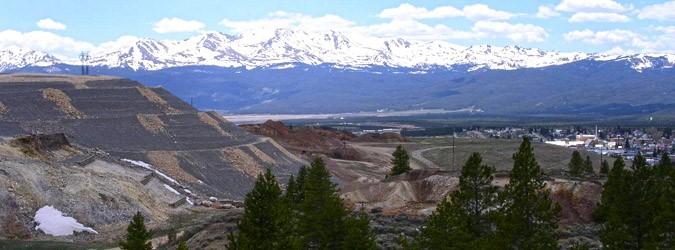Leadville is one of Colorado’s most historic mountain towns. Though a small mountain town today, in the 1870s and 1880s Leadville rivaled Denver for the state’s most prestigious city and many millionaires were made through Leadville’s silver mines. Following the Crash of 1893, most of Leadville’s silver mines were abandoned, although other mining activities such as molybdenum mining did continue in Leadville through the twentieth century.
Because of the sheer volume of mining near Leadville, the entire town is included in the 18-square-mile California Gulch superfund site. While much of the site has been cleaned up, there is still continual monitoring of the site and cleanup of some areas is still ongoing. Much of the cleanup work began after the Colorado Department of Public Health & Environment and federal partners undertook a major study of the area in 1990.
The Leadville Metals Exposure Study, available digitally from our library, reported that “soil surveys done in connection with a remedial investigation of [the site] found elevated levels of lead (Pb), arsenic (As), and Cadmium (Cd) in surface soils in residential areas. A study of heavy metal exposure to individuals living in Leadville, Colorado is described in this report.” The report especially focused on the exposure of children to toxic lead. “Studies have linked lead in the blood of children to lead in dust on children’s hands to lead in floor and sill dust in houses and to lead in the soil outside the children’s houses.” The study presents detailed data on the lead exposure to humans in Leadville, including comparisons to other places in the United States.
The following year, another study, this one by the Colorado Water Resources Research Institute at Colorado State University, measured the effects of the metal contamination on the water quality in the California Gulch site. Entitled Fate and Effects of Heavy Metals on the Arkansas River, this publication is also available online from our library.
Twenty-five years later, the site is still undergoing remediation. The EPA website reports that the “human exposure status” is still “not under control,” although the “contaminated ground water status” has been controlled. For more documents relating to mining, hazardous waste, and public health, search our library’s online catalog.

- How to Spot the Differences Between Eagles and Hawks - August 16, 2021
- How Transportation Projects Help Tell the Story of Colorado’s Past - August 9, 2021
- Time Machine Tuesday: The Night the Castlewood Canyon Dam Gave Way - August 3, 2021
